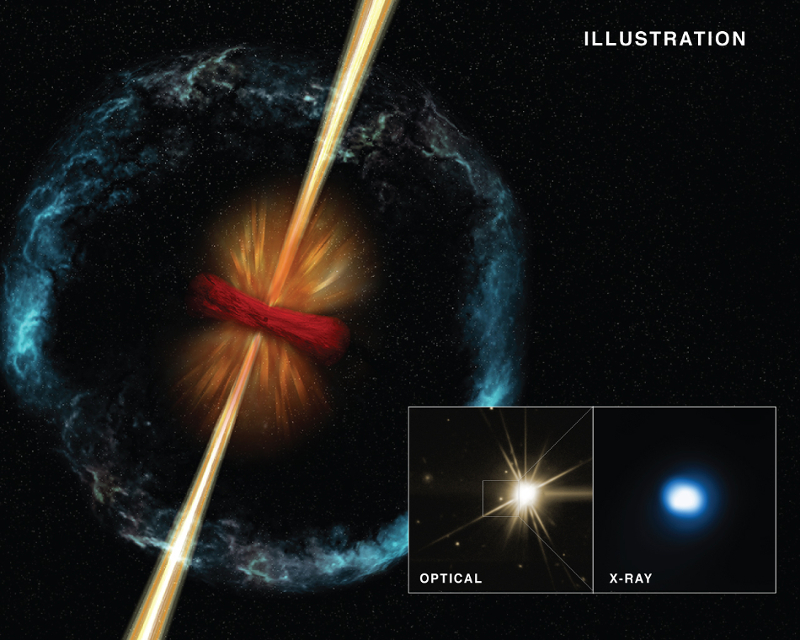
 Credit: X-ray: NASA/CXC/Univ. of Maryland/E. Troja et al, Optical: Lowell Observatory's Discovery Channel Telescope/E.Troja et al. Illustration: NASA/CXC/M.Weiss
Credit: X-ray: NASA/CXC/Univ. of Maryland/E. Troja et al, Optical: Lowell Observatory's Discovery Channel Telescope/E.Troja et al. Illustration: NASA/CXC/M.Weiss
Neutron Stars and the Dance of Death
Gamma-ray bursts are among the most powerful stellar explosions known. GRBs were discovered in the 1960s, but only announced to the general scientific community in the 1970s, after it was recognized that these bursts are cosmic in origin, and not due to some nefarious terrestrial cause. Gamma-ray bursts are produced by massive stars, either directly through the explosion of an extremely massive star after the star runs out of thermonuclear fuel and collapses, or indirectly through the merger of two neutron stars left behind after the explosion of massive stars in binary systems. Strong evidence of mergers is hard to obtain, because the merger event is so short. However, a gamma-ray burst which occurred on September 3, 2014, seems to be a very good example of a GRB produced by the merger of two neutron stars. The GRB was discovered by NASA's Swift Burst Alert Telescope, which saw a very short burst of Gamma-rays, lasting only about 2 seconds. Follow-up observations with the Chandra X-ray Observatory, the Discovery Channel Telescope, and other observatories showed that the afterglow of the GRB rapidly faded in brightness.
The small image above shows an optical view from the Discovery Channel Telescope (DCT) with GRB 140903A in the middle of the square on the left (The bright star in the optical image is unrelated to the GRB) and the X-ray image of the GRB afterglow from Chandra on the right. The illustration above shows a model of a neutron star merger. We think a merger will produce a black hole with an accretion disk around it and a narrow, powerful beam of particles and radiation powered by the release of energy from the infalling material.
The behavior of the immediate gamma-ray emission observed by Swift, the lack of a bright supernova shown by the Chandra and DCT observations, and the age and low star-formation rate of the galaxy in which the GRB exploded, provide the best evidence to date that this GRB was produced by a merger of two neutron stars. In addition to being a bright source of electromagnetic gamma-ray radiation, such mergers should also be strong emitters of gravitational radiation; how many will be seen by existing and new gravitational wave observatories?
Published: August 9, 2016
<
HEA Dictionary ● Archive
● Search HEAPOW
● Other Languages
● HEAPOW on Facebook
● Download all Images
● Education ● HEAD
gt;

Each week the HEASARC
brings you new, exciting and beautiful images from X-ray and Gamma ray
astronomy. Check back each week and be sure to check out the HEAPOW archive!
Page Author: Dr. Michael F. Corcoran
Last modified Tuesday, 27-Feb-2024 10:15:16 EST


